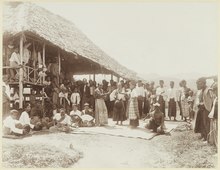
Back ماك يونغ Arabic Mak yong DAG Mak yong DGA Mak Yong Spanish Mak Yong French Mak Yong Croatian Mak Yong ID Мак јонг Macedonian Mak Yong Malay Mak Yong Dutch
 Mak yong dance and drama at Penang, c.1903 | |
| Native name | Tarian Mak Yong |
|---|---|
| Origin | Malaysia |
| Mak Yong Theatre | |
|---|---|
| Country | Malaysia |
| Reference | 0167 |
| Region | Asia and the Pacific |
| Inscription history | |
| Inscription | 2008 |
| Mak yong |
|---|
|
| Burma |
| Cambodia |
| Indonesia |
|
| Laos |
| Malaysia |
| Philippines |
| Singapore |
| Thailand |
|
| Vietnam |
Mak yong (Jawi: مق يوڠ; Thai: มะโย่ง, RTGS: ma yong) is a traditional form of dance-drama from northern Malaysia, particularly the state of Kelantan. It was banned by the Pan-Malaysian Islamic Party because of its animist and Hindu-Buddhist roots which pre-date Islam in the Asian region by far.[1] The late Cik Ning was a leading mak yong performer in the 1980s. In 2005, UNESCO declared mak yong theatre a "Masterpieces of the Oral and Intangible Heritage of Humanity".[2]
Although most traditional Malay dances were influenced by India, Java, and other parts of Southeast Asia, Mak yong's singing and musical repertoire are unique to the region. Of the major stories performed in Mak yong, most are derived from Kelantan-Patani mythology. Some of those obtained from outside the Malayan-Thai region have now died out elsewhere, such as Anak Raja Gondang, a story originally from the Buddhist Jataka tales but now almost unknown in India.
A performance begins by paying respect to the spirits (semah kumpung) with an offering. This is followed by dancing, acting, and improvised dialogues. Stories were presented in a series of three-hour performances over several nights. The lead dancer is called the Pak Yong and dresses like a king. The cast usually includes a queen in second lead, palace girls, and jesters. Traditionally, all performers were female except for the clowns who are always male. A group called Jong Dongdang sings and dances in between chapters and at the story's closing. The mak yong orchestra is small with the main instruments played being the three-stringed spiked lute, drum (gendang), and a pair of gong. It may also include the flute (serunai), keduk drums and small cymbals (kesi).
Today there is less than ten veterans mak yong performers. Although there have been a few attempts to revive the art form, seasoned performers have noted a clear difference between the commercialized mak yong of urban dancers when compared with the movements of rural performers. Not many young people are willing to undergo the rigorous apprenticeship so the art is now on the decline.
- ^ "Kelantan refuses to lift Mak Yong ban". The Star. 2007. Retrieved 5 December 2017.
- ^ "Mak Yong Malaysia". UNESCO. 2008. Retrieved 5 December 2017.
